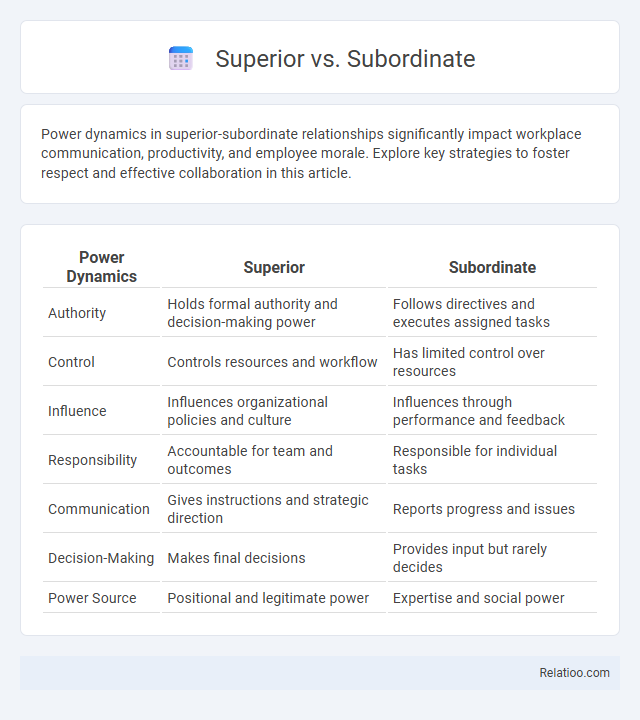Power dynamics in superior-subordinate relationships significantly impact workplace communication, productivity, and employee morale. Explore key strategies to foster respect and effective collaboration in this article.
Table of Comparison
| Power Dynamics | Superior | Subordinate |
|---|---|---|
| Authority | Holds formal authority and decision-making power | Follows directives and executes assigned tasks |
| Control | Controls resources and workflow | Has limited control over resources |
| Influence | Influences organizational policies and culture | Influences through performance and feedback |
| Responsibility | Accountable for team and outcomes | Responsible for individual tasks |
| Communication | Gives instructions and strategic direction | Reports progress and issues |
| Decision-Making | Makes final decisions | Provides input but rarely decides |
| Power Source | Positional and legitimate power | Expertise and social power |
Understanding the Superior-Subordinate Relationship
The superior-subordinate relationship defines the hierarchical dynamic where the superior holds authority and responsibility over tasks, performance, and guidance, while the subordinate executes assigned duties and follows directives. Understanding this relationship is crucial for effective communication, role clarity, and organizational efficiency, as power, accountability, and respect intersect. Clear definitions of superior, subordinate, and the process of subordination enhance leadership effectiveness and employee engagement within businesses and institutions.
Defining Roles: Who is a Superior and Who is a Subordinate?
A superior is an individual or entity in a higher hierarchical position with authority and decision-making power over subordinates, who occupy lower ranks and are responsible for following instructions and executing tasks. Subordination refers to the structured relationship where subordinates are obligated to comply with the directives issued by superiors within organizational, military, or social contexts. Understanding these roles clarifies the dynamics of authority, responsibility, and accountability essential for effective management and command.
Key Differences Between Superiors and Subordinates
Superiors hold higher authority and decision-making power within an organizational hierarchy, while subordinates execute tasks and follow directions. The key differences between superiors and subordinates include responsibility levels, autonomy in work, and influence over team dynamics. Understanding your role clarifies expectations and improves communication between different organizational levels.
Communication Dynamics in the Hierarchy
Communication dynamics in hierarchical structures reveal that superior roles often dictate decision-making and information flow, emphasizing clarity and authority in directives. Subordinates typically engage in feedback channels, which require active listening and responsiveness to maintain organizational coherence. Subordination defines the power differential that influences communicative behaviors, where respect for rank shapes message framing and reception effectiveness.
Leadership Styles and Their Impact on Subordinates
Leadership styles significantly influence the dynamic between superior and subordinate roles, shaping workplace morale and productivity. Transformational leaders inspire subordinates by fostering empowerment and creativity, whereas authoritarian leaders emphasize strict control and compliance, often leading to reduced autonomy. Your ability to adapt leadership approaches can enhance subordinate engagement and drive organizational success through a balanced blend of guidance and independence.
The Importance of Mutual Respect in the Workplace
Mutual respect between superior and subordinate roles fosters a positive work environment where productivity and collaboration thrive. Your ability to recognize and value each team member's contributions strengthens workplace relationships and ensures smoother subordination processes. Prioritizing respect helps prevent misunderstandings and supports effective leadership and team cohesion.
Managing Conflict Between Superiors and Subordinates
Managing conflict between superiors and subordinates requires clear communication, effective negotiation skills, and mutual respect to foster a productive work environment. Understanding the power dynamics and addressing issues promptly helps prevent escalation and promotes collaboration. Your ability to balance authority with empathy can significantly improve conflict resolution and team cohesion.
Empowerment and Motivation of Subordinates
Empowerment of subordinates enhances motivation by granting autonomy and fostering a sense of ownership in tasks, which elevates their performance and job satisfaction. Superior leaders who practice effective empowerment encourage open communication and provide adequate resources, enabling subordinates to develop skills and take initiative confidently. Subordination without empowerment often results in decreased motivation, as rigid control limits creativity and engagement in the workplace.
Factors Influencing Superior Effectiveness
Factors influencing superior effectiveness include emotional intelligence, communication skills, and decision-making ability. Superior leaders demonstrate adaptability and motivate subordinates by setting clear goals and providing constructive feedback. Organizational culture and support systems also significantly impact a superior's capacity to lead effectively.
Building a Healthy Superior-Subordinate Relationship
Building a healthy superior-subordinate relationship requires clear communication, mutual respect, and trust between both parties. Your ability to provide constructive feedback and recognize your subordinate's efforts fosters motivation and productivity. Establishing transparent expectations and supporting professional growth helps create a balanced, respectful, and efficient workplace dynamic.

Infographic: Superior vs Subordinate
 relatioo.com
relatioo.com